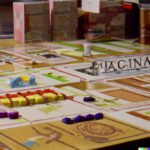Examples of Popular Board Games
Monopoly: The classic, family- friendly board game where players take control of properties in an attempt to become a real estate mogul. Players must build up their real estate empire by trading property to acquire the most wealth, which is the main way the game keeps score.
Risk: Risk is a strategic wargame that can be played with two to six people. Players collect armies and strategically place them on the planet-shaped game board in order to capture new territories, while each player has unique goals.
Scrabble: This popular word-game has been around since 1938, and it’s become one of the most recognizable games around! Every person takes 7 lettered tiles and comes up with words across and down on the game board. Scrabble requires strategy as well as creativity when selecting letters, making sure they create a maximum amount of points.
Ticket To Ride: A strategic route-building board game released in 2004 which allows players to choose destination (goals) cards for potential trips which increase their points. Players earn rewards for completing routes over large maps of North America or Europe.
Settlers of Catan: A Euro-style board game designed in 1995 that simulates building cities over land portions called hexes by rolling dice and generating resources based on those rolls and what type ofhex was rolled on (forest, hills, desert etc).
Parent/Teacher Resources
Board learning games provide a great way for students to learn in an engaging and fun environment. Parents and teachers can use these tools to supplement regular instruction and allow students opportunities to practice and test their skills in a variety of contexts. Popular board games like Stratego, Boggle, Scrabble, Connect 4, Monopoly, Chess, Risk, Clue and Checkers are all well-known examples of board learning games that can help teach children valuable problem-solving and critical thinking skills such as math, logic and strategy development.
The internet offers a wealth of resources for parents and teachers who want to explore the exciting possibilities of board learning games. Websites such as BoardGameGeek provide detailed reviews on various board game titles so that parents can choose the right game for their child or classroom. Other sites offer more specific advice on incorporating educational elements into existing game designs or creating new ones through DIY (Do It Yourself) Game Design Kits. Additionally, lesson plans featuring popular educational themes have been created for dozens of classic board choices. Parents and educators can find these worksheets online or create their own. Finally, there are several websites dedicated to providing tips and strategies from leading game designers professionals around the world which is perfect for those looking to plan challenging activities or just learn some additional trivia about their preferred board games!
DIY Games
Board learning games are a great way to help kids learn essential skills such as problem solving, communication, and teamwork. Making your own board learning game at home can be an economical and convenient way to have fun with your kids. Some everyday items that you can use for board learning games include cardboard, scissors, markers for drawing game pieces, play coins or bottle caps for counting, and small toys or figurines.
One easy idea would be to make a game of matching shapes. Cut out multiple squares or circles in different shades from card stock or construction paper. Draw a shape in its matching color on each piece of cardboard and set them out in pairs facing down on the board. As a race between two players, turn over one card at a time and match it up with its correct partner – whoever finds the most matches wins! You could also give the player bonus points if they find pairs of cards that match by color instead of just shape. You can easily switch this game up by using letters of the alphabet or numbers instead of shapes.
Another option is to create a junkyard scavenger game using toys and random objects like balls, buttons, sticks etc. Set these items out on the board and assign points for each item found – whoever collects more points is crowned champion! Try making your own ruleset like allowing double points if you find two items at once or even adding rules about where certain items must appear on the board to increase difficulty level if needed. This type of game encourages problem solving skills as well as working together if playing in teams!
Making DIY boards games doesn’t require any special materials ” all you need are items you already have lying around your house or items that can be found easily at a dollar store. Plus you get creative control over how the rules work and how long/difficult it takes to beat the game so there’s plenty of potential fun to be had right in your own living room!
Creative Uses
Board learning games are an awesome way to supplement learning fun in any subject. They can be tailored for use by children, teens and adults so anyone can benefit from the educational content regardless of their age or subject matter they may be studying. For younger students, board games provide an engaging way to practice different concepts while having a stimulating and rewarding experience. Games can also introduce new concepts in a novel way that is more entertaining than simply reading out of a book. A classic example of this is Monopoly. This timeless game teaches basic math skills such as money conversion and problem solving everyday decision-making scenarios like how to invest and where to invest your resources in order to gain rewards.
For older students, board learning games can help reinforce lessons they already understand while helping them apply their knowledge into a real world context. Examples include The Settlers of Catan which helps teach geography, history and economics all at once or Pandemic Legacy which allows players to explore political tensions between the various nations represented in the game from week to week as alliances break down and circumstances change over time. Board games give you the freedom to explore different perspectives, ideas, cultures and countries without leaving your home! By exploring board learning games, students are able to dive deeper into topics outside of the traditional lecture room setting providing them with innovative ways to review material and get creative with their education experience.
Combining Board Games with Technology
The rise of modern technology has seen many traditional board learning games made somewhat obsolete, replaced by more dynamic and interactive digital experiences. However, there is still a huge market for the classic board game, with people of all ages enjoying playing them in person.
In recent years, some companies have started to combine technology with the fun and familiarity of traditional board games to create hybrid versions that connect further with players. This combination of board gaming and technology offers new opportunities and levels of interactivity. Players can access additional content on their smart devices – providing extra depth to their game experience – or play against opponents online.
These online platforms also offer chances for teachers to create interactive virtual boards that let students test their skills in class while they learn valuable lessons in an engaging way. Smartboard functions also allow children to practice collaboration and creativity whilst honing technical skills such as using a mouse and keyboard. Therefore, by making use of these platforms it is possible for younger generations to expand on their board game skills without sacrificing any of the nostalgia associated with these classic titles.
Different Play Styles
Different play styles are important in board learning games. For example, one player might prefer to employ a analytical strategy where they think before making moves and consider possible outcomes. Another player may be more action-oriented and prefer to make quick decisions, emphasizing speed over accuracy. Additionally, some players might rely heavily on strategic planning while others could take a more intuitive approach like relying on experimenting with different combinations of game pieces.
By involving both types and styles of play, it can improve the overall enjoyment of the game and make it more engaging for all players involved. It is important for players to work together or have open communication about their strategies in order to create an effective synergy between players and thus result in a fun and interesting game experience. This also helps ensure that no single player has an unfair advantage as playing with multiple play styles allows for dynamic gameplay which keeps everyone involved actively engaged. Additionally, different play styles allow for a wider range of problem solving skills to be used in order to better understand the game’s mechanics, such as counting variations or breaking down puzzles into individual components. Ultimately, understanding different play styles can lead to improved engagement and collaboration during gameplay, resulting in increased learning throughout the entire game process.

I love playing all kinds of games – from classics like Monopoly to modern favourites like Ticket to Ride.
I created this blog as a way to share my love of board games with others, and provide information on the latest releases and news in the industry.





